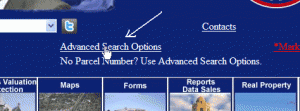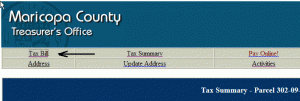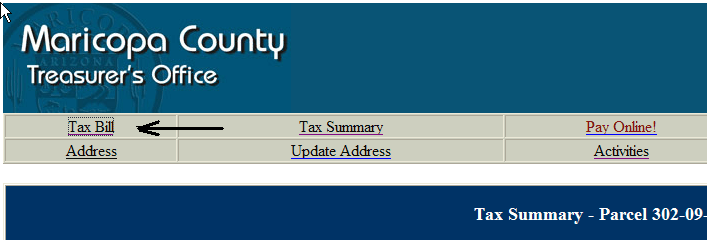Maricopa County Tax Bills Arrived – Some Happy, Some Not
The motivation for this article comes from all the recent news about taxes, and some buyers who say interesting things like “The property values have gone down, so the taxes better be lower!” With that I thought it was the right time to dig in and get to the bottom of this sensitive topic. I’m glad I did because there are some interesting facts of which I was unaware. Read on and find out what is myth, what is reality, and discover some unknown facts.
The Basics of Maricopa Property Valuation- Limited Cash Value and Full Cash Value, and primary and secondary taxes
There are two assessed values used in determining your tax bill. The primary assessment is called the “Limited Value”, and the “Full Cash Value” is the secondary assessment . Most of the time they are the same value; however the limited value can never be higher than the full cash value. Besides the possibility of being different numbers, each one is used in the computation of different taxes.
The Limited Property Value (LPV) assessment used to calculate primary taxes is determined by a statutory formula mandated by the Arizona State Legislature. The Maricopa County Assessor’s website further explains, “The LPV is used to compute primary taxes for the maintenance and operation of school districts, cities, community college districts and counties. The LPV cannot exceed the property’s Full Cash Value.” In most cases, the primary tax based on the limited value assessment is the larger portion of property taxes.
The Full Cash Value(FCV) is intended to be a reflection of the market value of the property including land and improvements. Quoting again from the Assessor’s website, “The FCV is used to compute secondary taxes, which may consist of bonds, budget overrides, and special districts such as fire, flood control, and other limited purpose districts.” When you appeal the valuation, you are challenging the Full Cash Value portion of the assessment. For more information on this process, click on appealing the property tax valuation.
The devil is in the details of your tax bill
To really understand what is happening with your tax bill you need to drill down and identify each component. The general categories under which taxes are listed are Primary(Limited) Tax Amounts, Secondary (Full Cash) Tax Amounts, and Special District Details. The line item details of these categories are very revealing and explain why taxes decrease or increase. For example, those living in the Nadaburg Elementary School District were significantly impacted and most likely surprised by the increase from 2009 to 2010. Below is the actual tax detail for a resident in Wittman whose overall taxes increased from $1,318 in 2009 to $2,055 in 2010 due to a 346% increase in the Nadaburg Elementary School district assessment, or $961. See line item detail below.
This is why it is important to understand and analyze the specific line items of your tax bill.
Analyzing the details of you Maricopa County Tax bill
To see the detail of your taxes start out at the Maricopa County Assessor’s website. Look for the “Advanced Search Options” link which will take you to a page where you can enter your address. You’ll be able to search based on address, subdivision, or your last name and street.
Once you’re on the assessor’s page for your property, you can access the Maricopa County Treasurer’s website (where the tax line item detail resides) via a link on the assessor’s page. Look for the link “View Tax Information”.
This will take you to the Maricopa County Treasurer’s website (don’t give up we’re almost there!) This will tell you  your most current tax bill as well as the history for your property. The last link you’ll need to click is the “Tax Bill” link in the upper left hand corner of the page. The tax bill page will break down your property taxes by line item detail and you can also see which special tax district assessments you pay for at the bottom of the page. Make sure and scroll down to see the individual taxes. It’s also nice because it shows the previoius year vs. the current year tax liability. While my overall property tax bill went down, there were some that did increase. You’ll also notice that the majority of your taxes go towards education.
your most current tax bill as well as the history for your property. The last link you’ll need to click is the “Tax Bill” link in the upper left hand corner of the page. The tax bill page will break down your property taxes by line item detail and you can also see which special tax district assessments you pay for at the bottom of the page. Make sure and scroll down to see the individual taxes. It’s also nice because it shows the previoius year vs. the current year tax liability. While my overall property tax bill went down, there were some that did increase. You’ll also notice that the majority of your taxes go towards education.
Remember the assessor sets the valuation of the property and the treasurer’s office assigns the taxes for the property based on the assessed values, but these activites take place at different times of the year. You receive your notice of valuation typically in February of valuation of your property for the next calendar year.
The next important event is in September when property owners are advised of their tax liability for that year. You may say “Wow, we find out almost 3/4 of the way through the year of our taxes for that year?” Correct, but you also pay your taxes in arrears so the first half taxes are due October 1st, and the second half are due March 1st of the next year.
Lastly, there is a common but mistaken belief that property taxes should rise and fall in sync with property value. That’s very appealing right now when home values have fallen. Charles Hoskins, the Maricopa County treasurer answered the question in a recent article in The Arizona Republic, “We often hear from citizens wanting to know why their tax bills have gone up, even though the assessed value of their property has gone down. And the answer is increased government spending,” Operating budgets are established which drives the total tax levy required via direct taxation and then the tax rates are set to support the budgets.
I believe the best way to summarize the process is property values and assessments do NOT determine the total taxes that will be collected. They only determine the DISTRIBUTION of the total tax levy among homeowners.
Fortunately, Arizona has the 39th lowest property taxes in the nation. Just ask anyone who has relocated from back east. My sister lived in New Jersy and her property taxes were more than my total house payment! One town in Massachusetts has seen their property taxes increase 64% since 2000. Right now many homeowners are seeing their taxes turned back to what they were paying during 2000 or 2001. But every property’s tax will be different so check out the Treasurer’s website and see how yours compare.
Related Post:
The AZ Jobs Bill and its affect on residential property taxes






